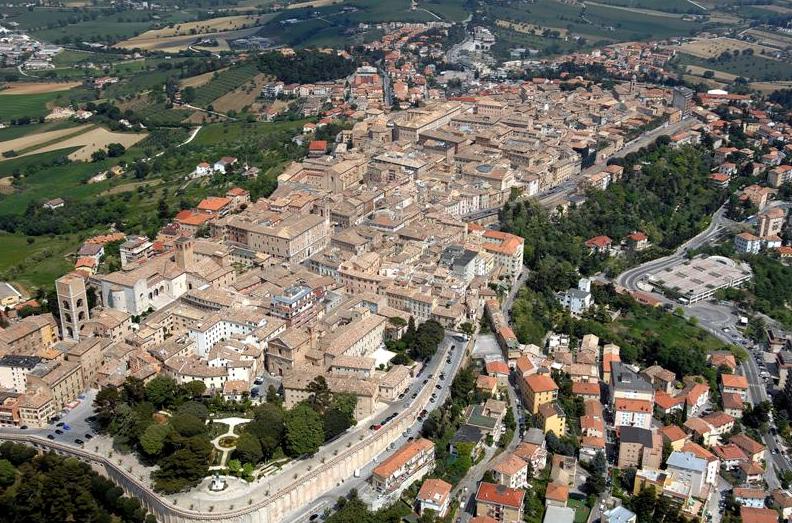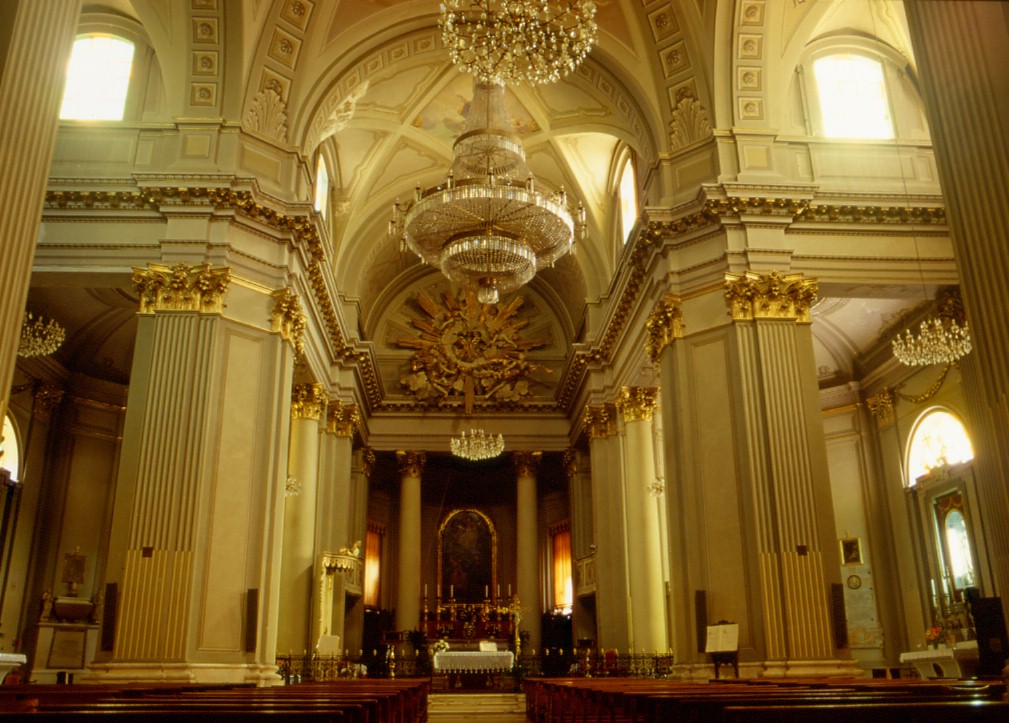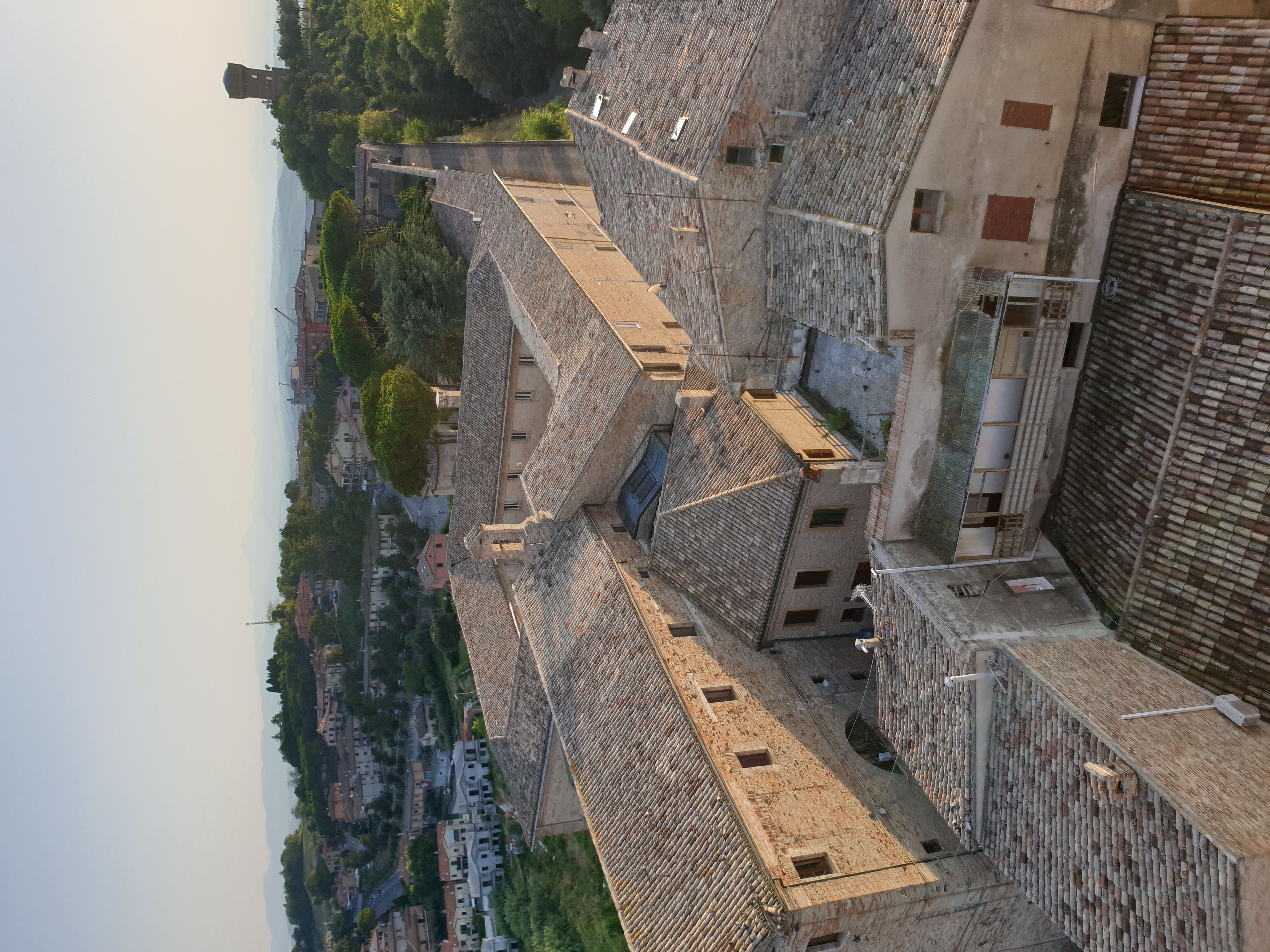|
Andrea Vici
Andrea Vici (1743–1817) was an Italian architect and engineer, active in a Neoclassical style. He was a pupil of Luigi Vanvitelli, and active in the Papal States comprising parts of Lazio, Umbria, and Marche. Biography Andrea was born in Arcevia in the Marche, the brother of Arcangelo, who was also an architect of note, leaving behind works at Jesi, Arcevia, Fano, Corinaldo, and Cupramontana. At the age of 14, Andrea was given a classical education in mathematics, letters and design by Francesco Appiani at Perugia. At the age of 17 he joined the studio of the painter Cesare Pozzi in Rome, then studied architecture under Carlo Murena. At the age of 26 years, he was recruited by the eminent architect Luigi Vanvitelli to work at the Reggia di Caserta and in the church of the Santissima Annunziata in Naples. Moving to the Papal states, he became an important architect and engineer. He was named Count and later palatine prince, president of the Pontifical Academy of St Luke in Rom ... [...More Info...] [...Related Items...] OR: [Wikipedia] [Google] [Baidu] |
Neoclassical Architecture
Neoclassical architecture is an architectural style produced by the Neoclassical movement that began in the mid-18th century in Italy and France. It became one of the most prominent architectural styles in the Western world. The prevailing styles of architecture in most of Europe for the previous two centuries, Renaissance architecture and Baroque architecture, already represented partial revivals of the Classical architecture of ancient Rome and (much less) ancient Greek architecture, but the Neoclassical movement aimed to strip away the excesses of Late Baroque and return to a purer and more authentic classical style, adapted to modern purposes. The development of archaeology and published accurate records of surviving classical buildings was crucial in the emergence of Neoclassical architecture. In many countries, there was an initial wave essentially drawing on Roman architecture, followed, from about the start of the 19th century, by a second wave of Greek Revival architec ... [...More Info...] [...Related Items...] OR: [Wikipedia] [Google] [Baidu] |
Metastasio
Pietro Antonio Domenico Trapassi (3 January 1698 – 12 April 1782), better known by his pseudonym of Pietro Metastasio (), was an Italian poet and librettist, considered the most important writer of ''opera seria'' libretti. Early life Metastasio was born in Rome, where his father, Felice Trapassi, a native of Assisi, had taken service in the Corsican regiment of the papal forces. Felice married a Bolognese woman, Francesca Galasti, and became a grocer in the ''Via dei Cappellari''. The couple had two sons and two daughters; Pietro was the younger son. Pietro, while still a child, is said to have attracted crowds by reciting impromptu verses on a given subject. On one such occasion in 1709, two men of distinction stopped to listen: Giovanni Vincenzo Gravina, famous for legal and literary erudition as well as his directorship of the Arcadian Academy, and Lorenzini, a critic of some note. Gravina was attracted by the boy's poetic talent and personal charm, and made Pietro h ... [...More Info...] [...Related Items...] OR: [Wikipedia] [Google] [Baidu] |
Camerino Cathedral
Camerino Cathedral ( it, Duomo di Camerino, ''Cattedrale di Santa Maria Annunziata'') is a Neoclassical Roman Catholic cathedral and minor basilica, dedicated to the Annunciation, in Camerino, Region of Marche, Italy. Since 1987 it has been the seat of the Archbishop of Camerino-San Severino Marche, having been the seat of the Archbishops of Camerino from 1787 and previously that of the Bishops of Camerino. History The present church was built in 1802-1832 based on designs by Andrea Vici and Clemente Folchi. It was erected on the site of the previous medieval Romanesque-Gothic cathedral, destroyed in the 1799 earthquake. The sacristy still houses works such as a 13th-century painted crucifix, a 15th-century icon of the ''Madonna della Misericordia'', and other paintings. The church once housed a large polyptych by Carlo Crivelli, which was disassembled and sold: the central panel is now in the Pinacoteca di Brera in Milan. One of the chapels once contained frescoes, now lost, ... [...More Info...] [...Related Items...] OR: [Wikipedia] [Google] [Baidu] |
Fossombrone Cathedral
Fossombrone Cathedral ( it, Cattedrale di Sant'Aldebrando or ''dei Santi Aldebrando e Agostino''; ''Duomo di Fossombrone'') is a Roman Catholic cathedral dedicated to Saint Aldebrandus and Saint Augustine located in the Piazza Mazzini at the end of Corso Garibaldi in the center of the town of Fossombrone in the province of Pesaro and Urbino in the region of Marche, Italy. Formerly the cathedral of the Diocese of Fossombrone, since 1986 it has been a co-cathedral of the Diocese of Fano-Fossombrone-Cagli-Pergola. History The church site was formerly that of a Benedictine abbey. Between 1776 and 1784 the church was completely rebuilt in Neoclassical style, with the exception of the 15th-century campanile, by the architect Cosimo Morelli. It has a tall central façade with monumental columns supporting a triangular tympanum. The interior contains three naves with polychrome altars, made of marble and scagliola, designed by Nicola Vici. The altarpieces depict: the ''Madonna and Ch ... [...More Info...] [...Related Items...] OR: [Wikipedia] [Google] [Baidu] |
Fabriano
Fabriano is a town and ''comune'' of Province of Ancona, Ancona province in the Italy, Italian region of the Marche, at Above mean sea level, above sea level. It lies in the Esino valley upstream and southwest of Jesi; and east-northeast of Fossato di Vico and east of Gubbio (both in Umbria). Its location on the main highway and rail line from Umbria to the Adriatic make it a mid-sized regional center in the Apennine Mountains, Apennines. Fabriano is the headquarters of the giant appliance maker Indesit (partly owned by Whirlpool Corporation, Whirlpool). Fabriano, with Roma, Parma, Torino and Carrara, is an Italian Creative Cities Network, creative city (UNESCO). The town is in the category ''Folk Arts'' (for the Fabriano's handmade paper production). History Fabriano appears to have been founded in the early Middle Ages by the inhabitants of a small Roman town south at Attiggio (Latin ''Attidium''), of which some slight remains and inscriptions are extant. Fabriano itself wa ... [...More Info...] [...Related Items...] OR: [Wikipedia] [Google] [Baidu] |
Falconara Marittima
Falconara Marittima is a seaside resort on the Adriatic coast, in Italy, located north of Ancona, in the Marche region, province of Ancona. History Falconara developed around a castle. In the second half of the 16th century it was bought by the noble family of Bourbon del Monte. In the 19th century they were still present as owners. The Castle of Falconara, together with those of Rocca Priora and of Castelferretti, represented a defence system around Ancona, which controlled the territory and demanded bridge toll for crossing over the river Esino and had many other functions. Demographics , 90.94% of the population was Italian. The largest immigrant group came from Albania and Romania 4.75%, followed by North Africa 1.17%. Sights Falconara Marittima's main attraction is a long sandy beach where during the summer people practice sports such as beach volleyball, beach tennis and beach soccer. Falconara has a zoo. Every year on 15 August, the Ferragosto holiday a fireworks displa ... [...More Info...] [...Related Items...] OR: [Wikipedia] [Google] [Baidu] |
Santa Caterina, Cingoli
Santa Caterina is a Roman Catholic church located in the town of Cingoli, province of Macerata, region of Marche Marche ( , ) is one of the twenty regions of Italy. In English, the region is sometimes referred to as The Marches ( ). The region is located in the central area of the country, bordered by Emilia-Romagna and the republic of San Marino to the ..., Italy. History The church was built originally in 1217 near the Hospital ''dello Spineto''. It was reconstructed in the first half of the 18th century in its present state. The interior has a centralized plan and contains a decorated choir area. in the Comune of Cingoli. References {{DEFAULTSORT:Caterina Cingoli[...More Info...] [...Related Items...] OR: [Wikipedia] [Google] [Baidu] |
Basilica Of Loreto
The Basilica della Santa Casa ( en, Basilica of the Holy House) is a Marian shrine in Loreto, in the Marches, Italy. The basilica is known for enshrining the house in which the Blessed Virgin Mary is believed by some Catholics to have lived. Pious legends claim the same house was flown over by angelic beings from Nazareth to Tersatto (Trsat in Croatia), then to Recanati, before arriving at the current site. The basilica is also known for enshrining the Madonna and Child image of "Our Lady of Loreto". Pope Benedict XV designated the religious image as patroness of air passengers and auspicious travel on 24 March 1920. Pope Pius XI granted a Canonical Coronation to the venerated image made of Cedar of Lebanon wood on 5 September 1922, replacing the original Marian image consumed in fire on 23 February 1921. The church The basilica containing the ''Santa Casa'' is a Late Gothic structure built starting from 1468, and continued by Giuliano da Maiano, Giuliano da San ... [...More Info...] [...Related Items...] OR: [Wikipedia] [Google] [Baidu] |
Osimo
Osimo is a town and ''comune'' of the Marche region of Italy, in the province of Ancona. The municipality covers a hilly area located approximately south of the port city of Ancona and the Adriatic Sea. , Osimo had a total population of 35,037. History Vetus Auximum was founded by the same Greek colonists of Ancona; later it was contested by the Gauls and the Picentes until conquered by the Romans, who used it as a fortress for their northern Picenum settlement starting from 174 BCE. The walls were made of large rectangular stones which are still visible in some locations. It was a colony until 157 BCE. The family of Pompey were its protectors and resisted Julius Caesar in 49 BCE. Inscriptions and monuments in its town square attest to the importance of Osimo during imperial times. In the 6th century it was besieged twice in the course of the Gothic War (535–554) by Belisarius and Totila; the Byzantine historian Procopius said it was the leading town of Picenum. Osimo was a ... [...More Info...] [...Related Items...] OR: [Wikipedia] [Google] [Baidu] |
Treia
Treia is a town and ''comune'' in the province of Macerata in the central Marche (Italy). It is north of Pollenza, west of Macerata, and north-northeast of Tolentino. Geography The site of the abandoned Roman municipium of Trea is situated in the middle valley of the River Potenza, some 30 km from the Adriatic shore. The town was located on a dominant plateau, 1 km north-west of present-day Treia, and just 3 km east of Monte Pitino, in an agrarian area around the church and convent of SS. Crocifisso. Remains The only remaining visible ruins are two small sections of the former city walls, partly incorporated in a now abandoned farm house. Since the 16th century many isolated finds as well as epigraphic monuments concerning Trea have been discovered in the general area. The first major excavations by Fortunato Benigni in the late 18th century determined the town’s approximate location and revealed parts of its walls, a basilica and a sanctuary with possible ... [...More Info...] [...Related Items...] OR: [Wikipedia] [Google] [Baidu] |
Treia Cathedral
Treia Cathedral, otherwise the Church of the Annunciation ( it, Duomo di Treia, Concattedrale della Santissma Annunziata, ) is a Roman Catholic cathedral in the city of Treia, Macerata, Italy, dedicated to the Annunciation. It was formerly the seat of the bishop of Treia from the creation of the diocese of Treia in 1817 to its merging into the Diocese of San Severino in 1920, and following several other mergers is now a co-cathedral of the Diocese of Macerata-Tolentino-Recanati-Cingoli-Treia. The present structure, a re-building of a collegiate church, was erected between 1782 and 1814 to designs by the architect Andrea Vici (1743-1817), a pupil of Vanvitelli. It has a Greek cross ground plan with three naves, divided by Corinthian columns and pilasters. It has an enormous crypt nine metres high. The sacristy of the cathedral houses a painting depicting the ''Apparition of the Virgin Mary near the Convent of Forano to the Blessed Pietro da Treia and the Blessed Corrado d ... [...More Info...] [...Related Items...] OR: [Wikipedia] [Google] [Baidu] |
Offagna
Offagna is a ''comune'' (municipality) in the Province of Ancona in the Italian region of Marche, about southwest of Ancona. As of 31 December 2018, it had a population of 1,992 and an area of .All demographics and other statistics: Italian statistical institute Istat. Offagna borders the following municipalities: Ancona, Osimo, Polverigi Polverigi is a ''comune'' (municipality) in the Province of Ancona in the Italian region Marche, located about southwest of Ancona. Polverigi borders the following municipalities: Agugliano, Ancona, Jesi, Offagna Offagna is a '' comune'' (muni .... Demographic evolution Colors= id:lightgrey value:gray(0.9) id:darkgrey value:gray(0.8) id:sfondo value:rgb(1,1,1) id:barra value:rgb(0.6,0.7,0.8) ImageSize = width:455 height:303 PlotArea = left:50 bottom:50 top:30 right:30 DateFormat = x.y Period = from:0 till:3000 TimeAxis = orientation:vertical AlignBars = justify ScaleMajor = gridcolor:darkgrey increment:1000 start:0 ... [...More Info...] [...Related Items...] OR: [Wikipedia] [Google] [Baidu] |
_-_facade_on_Piazza_dei_signori.jpg)






